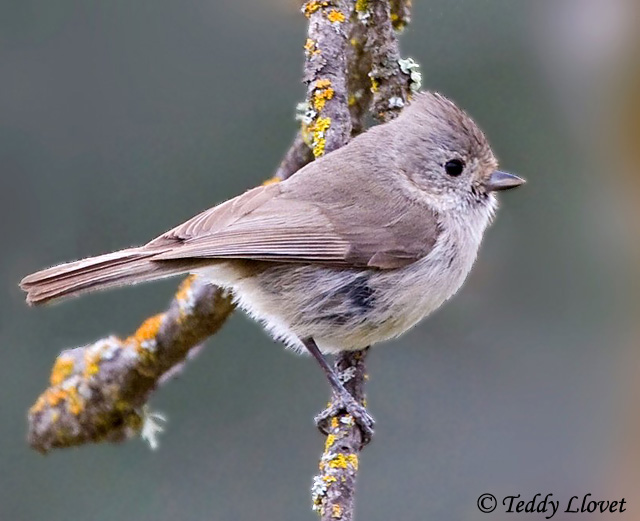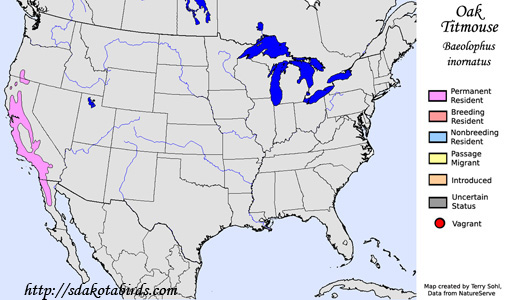| Length: 5.75 inches | Wingspan: 9 inches | Seasonality: Non-resident in South Dakota |
| ID Keys: Grayish overall with slight brownish tinge, lighter on underparts, small crest, very short stubby bill | ||
 The
Oak Titmouse and the Juniper Titmouse used to be considered a single
species, the "Plain Titmouse". The two are very similar in appearance,
but are separated by geographic range and preferred habitat. The Oak
Titmouse is found in warm, dry oak habitats, near the coast or around the
Central Valley of California. The Juniper Titmouse is in drier juniper
habitats of the inland southwestern United States.
The
Oak Titmouse and the Juniper Titmouse used to be considered a single
species, the "Plain Titmouse". The two are very similar in appearance,
but are separated by geographic range and preferred habitat. The Oak
Titmouse is found in warm, dry oak habitats, near the coast or around the
Central Valley of California. The Juniper Titmouse is in drier juniper
habitats of the inland southwestern United States.
Habitat: Found in oak and oak-juniper woodlands, riparian areas, and other deciduous woodland habitats.
Diet: Feeds on insects, nuts, seeds, and berries.
Behavior: Forages by moving actively through the woodland foliage, hopping from branch to branch and actively searching for insects.
Nesting: The Oak Titmouse forms strong pair bonds, mating for life. The nest is in a cavity in a tree, either a natural cavity, or an old woodpecker hole. The nesting cavity is lined with softer material such as mosses, grasses, or animal hair. The female lays between 6 and 8 eggs, and she alone incubates them. When the eggs hatch, both parents help to feed them. The young leave the nest after 2 to 3 weeks.
Song: The song of an Oak Titmouse is a series of whistled phrases, with considerable variability.
Migration: Considered a permanent resident throughout its normal range.
Interactive eBird Map: Click here to access an interactive eBird map of Oak Titmouse sightings
Similar Species: Juniper Titmouse, Tufted Titmouse. :However, ranges of those species do not overlap with the Oak Titmouse, except for a very small overlap in range with the Juniper Titmouse. In range, could also be confused with other small gray birds such as the Bushtit or Wrentit.
Feeders: Will attend feeders for various seeds and nuts, and for suet.
Conservation Status: Populations appear to be stable, and the IUCN lists the Oak Titmouse as a species of "Least Concern".
Further Information: 1) Wikipedia - Oak Titmouse
2) Audubon Guide - Oak Titmouse
3) Whatbird - Oak Titmouse
Photo Information: Photo taken by Teddy Llovet - February 23rd, 2010 - Photo licensed under Creative Commons Attribution NonCommercial 2.0 Generic License.
| Click below for a higher-resolution map |
 |
| South Dakota Status: Non-resident in South Dakota |
Additional Oak Titmouse Photos (Coming soon!)
